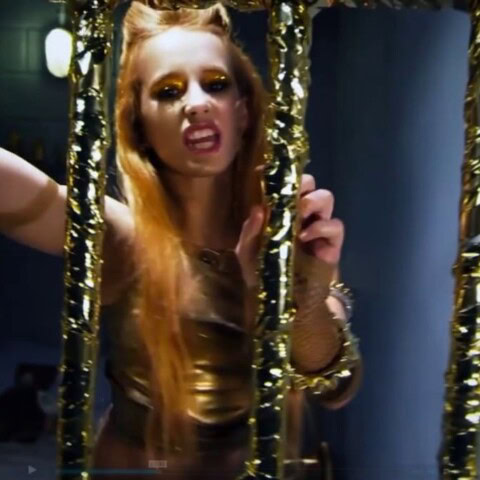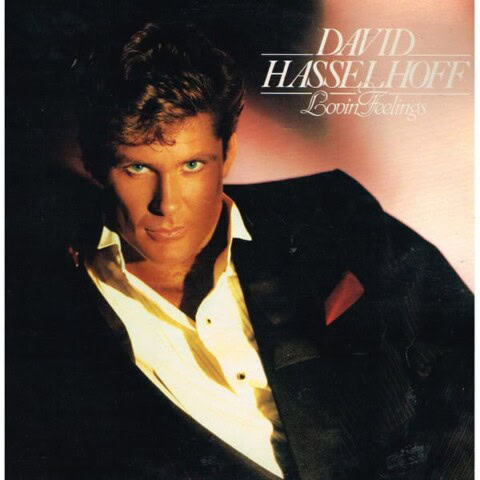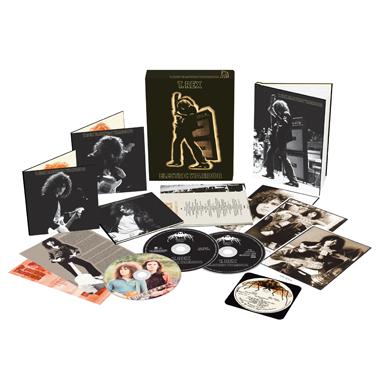 ZAPPA SCHOLARS TEND to get quite evasive about this troublesome entry in the discography. Recorded in a furious burst of activity almost simultaneously with Lumpy Gravy and We’re Only In It For The Money, and released in November 1968, Cruising With Ruben & The Jets pretended not to be an album by Zappa and The Mothers at all, but by a greasy doo-wop oriented group called Ruben & The Jets. [Ironically, a real group of this name formed in the ’70s!]
ZAPPA SCHOLARS TEND to get quite evasive about this troublesome entry in the discography. Recorded in a furious burst of activity almost simultaneously with Lumpy Gravy and We’re Only In It For The Money, and released in November 1968, Cruising With Ruben & The Jets pretended not to be an album by Zappa and The Mothers at all, but by a greasy doo-wop oriented group called Ruben & The Jets. [Ironically, a real group of this name formed in the ’70s!]
Consisting of 13 short songs, it would be as close as Zappa ever got to just getting on with the business of writing an album of pop songs. The problem for audiences in psychedelic ’68 was that the sounds harked back to both the doo-wop FZ had grown up with, and to the catchy but irritating white bubble-gum pop of the early ‘60s. That era wasn’t gone long enough to get nostalgic about, and fans were confused about Zappa’s intentions: was this a satire of moribund song forms, or an affectionate tribute? It would turn out to be a bit of both.
There’s much to enjoy about the album, but few of the compositional devices that fans loved about Zappa’s work: no harsh juxtapositions of song and sound experiment, no madcap theatricality, no instrumental passages and little soloing.
Adding to the confusion was the repetition of four tracks from the ‘commercial’ first disc of Freak Out! – re-recorded in more contained, disciplined versions for this project.
 “This is an album of greasy love songs and cretin simplicity”, states Zappa in the liner notes, and he’s right on the button. Apparently his inspiration was Stravinsky, whose later works were said to be a simulacrum of old-fashioned classical music; Zappa’s intention was to create a simulacrum of doo-wop and stupid bubblegum pop that was laced with a sugar substitute that was only one chemical step away from caustic soda. It worked, and the strangely antiseptic feel of the production aided in his concept/conceit. Zappa could have opted to make the record sound authentically raw and 1950s-like, but instead the harmonies and instruments are cleanly multi-tracked, and the rhythms, instead of the boisterous qualities associated with early rhythm’n’soul, have a strange, dissociative feel.
“This is an album of greasy love songs and cretin simplicity”, states Zappa in the liner notes, and he’s right on the button. Apparently his inspiration was Stravinsky, whose later works were said to be a simulacrum of old-fashioned classical music; Zappa’s intention was to create a simulacrum of doo-wop and stupid bubblegum pop that was laced with a sugar substitute that was only one chemical step away from caustic soda. It worked, and the strangely antiseptic feel of the production aided in his concept/conceit. Zappa could have opted to make the record sound authentically raw and 1950s-like, but instead the harmonies and instruments are cleanly multi-tracked, and the rhythms, instead of the boisterous qualities associated with early rhythm’n’soul, have a strange, dissociative feel.
If Ruben proves one thing, it’s that Zappa was capable of writing memorable, catchy pop songs, and that all the complexity of his later work wasn’t just dressage for mediocre song-writing, but it’s still perplexing, and for most fans is more of a curiosity than a core part of the bulging FZ discography.
That said, the album does have proponents amongst those who dislike Zappa’s most lauded releases, and that’s doubtless because these are songs with relatively simple structures and seemingly heartfelt vocals by Ray Collins of the original Mothers.
Although the songs tend to run together in their saccharine, uniform fashion, there are notable differences. For instance the opening shot, ‘Cheap Thrills’, is a clear precursor lyrically to the smutty lyrics of the ‘70s and ‘80s in lines like “Cheap thrills, in the back of my car/Cheap thrills, how fine they are… Cheap thrills, all over the seat/Cheap thrills, your kind of lovin’ can’t be beat.” So even here, he’s making fun of teen mores, and by turning back-seat passion into sticky stuff on seats, he’s strongly suggesting that so-called ‘love’ isn’t a matter of the heart, but a material fact driven by (in this case) teen hormones. [One of FZ’s key concerns was the materiality and actuality of existence and how to have fun with that, not cloud the issue with heart-on-sleeve emotions, and it runs right throughout his work.]
 Musically, ‘Cheap Thrills’ gets things off to an intentionally inauthentic start by using sped-up vocal harmonies, but also of note is the mindless, metronomic, machine-like repetition, a technique that Zappa utilised on several later songs, and seemed to relish. The repetition-technique is also used on ‘No, No, No’, which also uses chipmunk vocals and could quite conceivably have been a Money offcut.
Musically, ‘Cheap Thrills’ gets things off to an intentionally inauthentic start by using sped-up vocal harmonies, but also of note is the mindless, metronomic, machine-like repetition, a technique that Zappa utilised on several later songs, and seemed to relish. The repetition-technique is also used on ‘No, No, No’, which also uses chipmunk vocals and could quite conceivably have been a Money offcut.
The Freak Out! song ‘How Could I Be Such A Fool?’ is sung in a ridiculous falsetto, while the chorus, which uses multiple voices to repeat the title line, threatens to expose the hairy freaks behind the curtains working the doo-wop puppet show, and even a few psychedelically inclined guitar licks are allowed to spew forth to slightly alter the listener’s perception. It’s a weird effect, like listening to a clean-cut group of suit-wearing evangelists who’ve accidentally taken acid. Another Freak Out! song, ‘I’m Not Satisfied’, is also just a little demented around the fringes, making it like a ‘what’s wrong with this picture?’ exercise in audio.
The doo-wop facet of this album has been repeatedly emphasised, but the preppy bubblegum pop is equally pervasive, and one of the highlights is ‘Fountain Of Love’, a classic FZ double entendre with a very sincere sounding narration. Then again, it could be listened to as nothing more than a lovely smoochy ballad.
The two songs that break out a little and warp the picture the most are ‘Later That Night’ and the final song, ‘Stuff Up The Cracks’. Both of them emphasise what Zappa biographer/academic Ben Watson contends is an album “about claustrophobia and asphyxiation,” a theme that he reckoned reflected both the restrictions placed on the music for this project, and the 1950s era.
The scenario played out on ‘Later That Night’ is that the guy is being thrown out onto the street along with his worldly possessions, but it finishes off with a bondage twist, and lastly, a female voice saying nonchalantly: “That’s alright honey. You can come out of the closet now.”
‘Stuff Up The Cracks’, by contrast, is sung by a guy (the same guy?) who is threatening suicide if she ever leaves him: “Stuff up the cracks, turn on the gas, I’m gonna take my life.” Suicide prevention experts would probably blanche at the way Zappa takes the piss by responding with “Sss-stuff it!” Whatever, it’s a great song, and it even has a small concession to fans with the brilliant wah-wah guitar solo that concludes the song, and the album, and thoroughly breaks out of the ‘50s style so carefully adhered to elsewhere.
The big problem with Ruben – apart from its relative distance from the core of FZ’s oeuvre – is the fact that in 1984 Zappa re-recorded the bass and drum parts. Oddly, bassist Arthur Barrow and drummer Chad Wackerman aren’t credited, but this reissue sadly uses that butchered ‘80s remaster. This means that the real version of Ruben has never been issued on CD, unless you count Greasy Love Songs, a mailorder-only item from the Zappa Family Trust, and otherwise can only be obtained on expensive rare secondhand vinyl. While these replaced rhythm tracks fatten up the bass sound (some of which sounds like an electronically modified double bass), they just don’t sound right, and that’s why I find this CD hard to recommend.
In my opinion, reissuing the butchered version of this album again is a major blunder by the Zappa Family Trust, as FZ led us believe that there was never anything technically wrong with the original vinyl master: he just felt like re-recording the rhythm tracks for fun. GARY STEEL
Sound = 3.5/5
Music = 3.5/5

Frank Zappa – Cruising With Ruben & The Jets (Zappa Records/Universal) CD REVIEW
Latest from Music

Let there be drums!
Six diverse percussion compositions performed by virtuosic musician Justin DeHart challenge common notions about the most primal of instruments.

World’s Worst Records: Alison Gold’s Shush Up
Gold's follow-up to 'Chinese Food' was so regrettable and tasteless that she had to change her name, writes our dean of tack, MATT KELLY.

Heilung – A cyberpunk reimagining of ancient culture
Hardened atheist GARY STEEL attends bizarre show by German/Nordic group Heilung and has “spiritual” experience.

World’s Worst Records: David Hasselhoff’s Lovin’ Feelings
In part 2 of a survey of the complete musical works of Sir David Michael Hasselhoff, MATT KELLY describes a truly horrible record.

Wellington in the ’80s through the lens of an outsider music group
GARY STEEL reviews a new book that’s not only the story of an extraordinary band, label and scene, but an alternative history of Wellington









